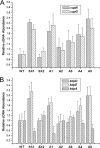Staphylococcus aureus AI-2 quorum sensing associates with the KdpDE two-component system to regulate capsular polysaccharide synthesis and virulence
- PMID: 20498265
- PMCID: PMC2916273
- DOI: 10.1128/IAI.00131-10
Staphylococcus aureus AI-2 quorum sensing associates with the KdpDE two-component system to regulate capsular polysaccharide synthesis and virulence
Abstract
Autoinducer 2 (AI-2) is widely recognized as a signal molecule for intra- and interspecies communication in Gram-negative bacteria, but its signaling function in Gram-positive bacteria, especially in Staphylococcus aureus, remains obscure. Here we reveal the role of LuxS in the regulation of capsular polysaccharide synthesis in S. aureus NCTC8325 and show that AI-2 can regulate gene expression and is involved in some physiological activities in S. aureus as a signaling molecule. Inactivation of luxS in S. aureus NCTC8325 resulted in higher levels of transcription of capsular polysaccharide synthesis genes. The survival rate of the luxS mutant was higher than that of the wild type in both human blood and U937 macrophages. In comparison to the luxS mutant, a culture supplemented with chemically synthesized 4,5-dihydroxy-2,3-pentanedione (DPD), the AI-2 precursor molecule, restored all the parental phenotypes, suggesting that AI-2 has a signaling function in S. aureus. Furthermore, we demonstrated that the LuxS/AI-2 signaling system regulates capsular polysaccharide production via a two-component system, KdpDE, whose function has not yet been clarified in S. aureus. This regulation occurred via the phosphorylation of KdpE binding to the cap promoter.
Figures







Similar articles
-
AI-2 quorum sensing negatively regulates rbf expression and biofilm formation in Staphylococcus aureus.Int J Med Microbiol. 2017 Jun;307(4-5):257-267. doi: 10.1016/j.ijmm.2017.03.003. Epub 2017 Apr 6. Int J Med Microbiol. 2017. PMID: 28416278
-
Staphylococcus aureus autoinducer-2 quorum sensing decreases biofilm formation in an icaR-dependent manner.BMC Microbiol. 2012 Dec 5;12:288. doi: 10.1186/1471-2180-12-288. BMC Microbiol. 2012. PMID: 23216979 Free PMC article.
-
AI-2 quorum sensing affects antibiotic susceptibility in Streptococcus anginosus.J Antimicrob Chemother. 2007 Jul;60(1):49-53. doi: 10.1093/jac/dkm124. Epub 2007 May 9. J Antimicrob Chemother. 2007. PMID: 17491000
-
The LuxS/AI-2 system of Streptococcus suis.Appl Microbiol Biotechnol. 2018 Sep;102(17):7231-7238. doi: 10.1007/s00253-018-9170-7. Epub 2018 Jun 25. Appl Microbiol Biotechnol. 2018. PMID: 29938319 Review.
-
Quorum sensing in Gram-negative bacteria: small-molecule modulation of AHL and AI-2 quorum sensing pathways.Chem Rev. 2011 Jan 12;111(1):28-67. doi: 10.1021/cr100109t. Epub 2010 Dec 23. Chem Rev. 2011. PMID: 21182299 Review. No abstract available.
Cited by
-
The Staphylococcus aureus autoinducer-2 synthase LuxS is regulated by Ser/Thr phosphorylation.J Bacteriol. 2010 Dec;192(23):6295-301. doi: 10.1128/JB.00853-10. Epub 2010 Sep 24. J Bacteriol. 2010. PMID: 20870760 Free PMC article.
-
Regulation of Staphylococcal Capsule by SarZ is SigA-Dependent.J Bacteriol. 2022 Aug 16;204(8):e0015222. doi: 10.1128/jb.00152-22. Epub 2022 Jul 11. J Bacteriol. 2022. PMID: 35862799 Free PMC article.
-
Quorum-sensing regulation in staphylococci-an overview.Front Microbiol. 2015 Oct 27;6:1174. doi: 10.3389/fmicb.2015.01174. eCollection 2015. Front Microbiol. 2015. PMID: 26579084 Free PMC article. Review.
-
The Ktr potassium transport system in Staphylococcus aureus and its role in cell physiology, antimicrobial resistance and pathogenesis.Mol Microbiol. 2013 Aug;89(4):760-73. doi: 10.1111/mmi.12312. Epub 2013 Jul 17. Mol Microbiol. 2013. PMID: 23815639 Free PMC article.
-
Sensor histidine kinases kdpD and aauS regulate biofilm and virulence in Pseudomonas aeruginosa PA14.Front Cell Infect Microbiol. 2023 Oct 10;13:1270667. doi: 10.3389/fcimb.2023.1270667. eCollection 2023. Front Cell Infect Microbiol. 2023. PMID: 37881370 Free PMC article.
References
-
- Ahmed, N. A., F. C. Petersen, and A. A. Scheie. 2007. AI-2 quorum sensing affects antibiotic susceptibility in Streptococcus anginosus. J. Antimicrob. Chemother. 60:49-53. - PubMed
-
- Altendorf, K., A. Siebers, and W. Epstein. 1992. The KDP ATPase of Escherichia coli. Ann. N. Y. Acad. Sci. 671:228-243. - PubMed
-
- Archer, G. L., and M. W. Climo. 2001. Staphylococcus aureus bacteremia—consider the source. N. Engl. J. Med. 344:55-56. - PubMed
-
- Ballal, A., B. Basu, and S. K. Apte. 2007. The Kdp-ATPase system and its regulation. J. Biosci. 32:559-568. - PubMed
Publication types
MeSH terms
Substances
LinkOut - more resources
Full Text Sources
Other Literature Sources
Molecular Biology Databases
Miscellaneous

